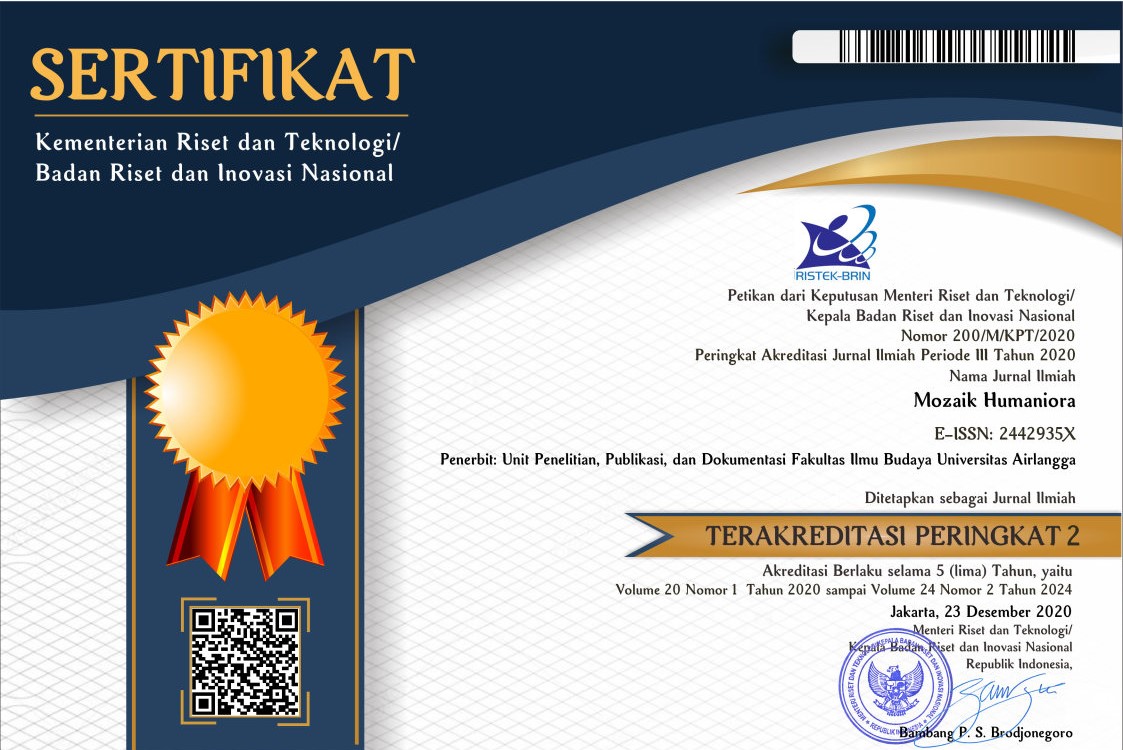Peran Semantis Subjek dalam Klausa Bahasa Muna
Downloads
ABSTRAK
Penelitian ini mengkaji beberapa peran semantis subjek dalam klausa bahasa Muna. Dalam berbagai bahasa, klausanya dimungkinkan memiliki sejumlah peran semantis. Begitu pula dengan bahasa Muna. Dalam tuturan sehari-hari, klausa merupakan unsur terpenting karena mengandung predikasi. Predikat sebagai penentu maksud pembicaraan. Di dalam klausa tersebut, subjeknya dapat saja berupa agen atau pasien. Dalam teori Role and Reference Grammar (RRG), agen dan pasien dikatakan sebagai peran umum, yaitu ACTOR dan UNDERGOER. Kedua peran semantis ini dapat saja hadir dalam satu klausa atau pun dapat hadir dalam satu klausa sekaligus. Penelitian ini termasuk dalam penelitian deskriptif kualitatif. Penelitian ini merupakan penelitian lapangan karena sumber data yang berupa data lisan berasal dari penutur atau informan. Penelitian ini menggunakan metode simak dan metode cakap dengan teknik sadap, teknik simak libat cakap, teknik rekam atau teknik catat, serta teknik pemancingan. Selanjutnya, data dianalisis dengan metode agih dan metode padan dengan teknik dasar bagi unsur langsung (BUL) sehingga analisis peran semantis subjek terlihat jelas. Analisis peran semantis subjek dalam klausa bahasa Muna mengacu pada teori Role and Reference Grammar (RRG). Hasil yang ditemukan, klausa bahasa Muna memiliki tiga peran semantis subjek, yaitu (1) klausa dengan SUBJEK memiliki peran semantis ACTOR, (2) klausa dengan SUBJEK memiliki peran semantis UNDERGOER, dan (3) klausa dengan SUBJEK memiliki peran semantis ACTOR sekaligus UNDERGOER. Klausa dengan peran semantis ACTOR sekaligus UNDERGOER dapat berupa klausa refleksif dan klausa resiprokal.Argumen UNDERGOER sebagai SUBJEK klausa dapat berupa entitas [-human] dan [+human].
Kata kunci: bahasa Muna, klausa, peran semantis subjek
ABSTRACT
This study concerns particular semantical roles of a subject in the clauses of Munansese language. In the Munanese language, the clause may have a number of semantical roles. In daily utterances, the clause is a constitute primary element because it has a predicate. The predicate determines the speaker's intended meaning in one conversation. In the clause, the subject can be an agent or patient. In Role and Reference Grammar theory, the agent and the patient can be called as an ACTOR and UNDERGOER. These semantical roles can be present at the same time in the clause. The study using a qualitative descriptive approach is a field research. The data were collected from the speakers' and informants' utterances. To collect the data, the methods included a close observation and conversation using a hidden recorder, taking some notes, and giving an improptu statement that needed an immediate response. The data were analyzed by directly dividing the elements of the clause named BUL (Bagi Unsur Langsung), so that the semantical roles of the subject could be identified. The results of the study show that the Munanese language clause has three semantical roles of the subject; (1) clauses with SUBJECT as ACTOR, (2) clauses with SUBJECT as UNDERGOER, and (3) clauses with SUBJECT as ACTOR andUNDERGOER. The clause having ACTOR and UNDERGOER as the semantic roles at the same time is reflexive and reciprocal clause. The argument, UNDERGOER, as SUBJECT may have such features as [-human] and[+human].
Keywords: clauses, Munanese language, semantical role of subject

Mozaik Humaniora is licensed under a Creative Commons Attribution-ShareAlike 4.0 International License. Both authors and Mozaik Humaniora agree with the following attribution of journal:
1. Copyright of this journal is possession of Author, by the knowledge of the Editorial Board and Journal Manager, while the moral right of the publication belongs to the author.
2. The journal allows the author(s) to retain publishing rights without restrictions
3. The legal formal aspect of journal publication accessibility refers to Creative Commons Attribution Share-Alike (CC BY-SA).
4. The Creative Commons Attribution Share-Alike (CC BY-SA) license allows re-distribution and re-use of a licensed work on the conditions that the creator is appropriately credited and that any derivative work is made available under "the same, similar or a compatible license”. Other than the conditions mentioned above, the editorial board is not responsible for copyright violation.


















